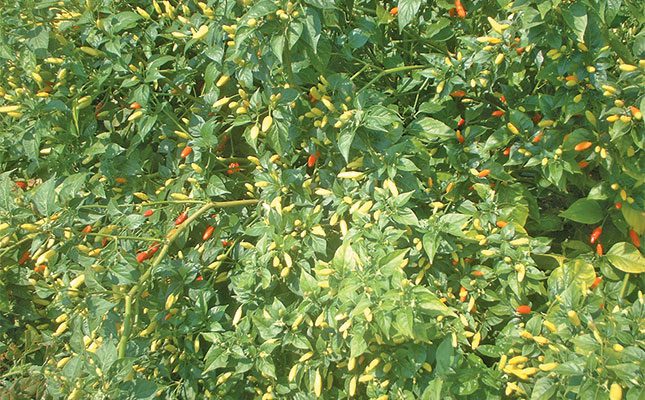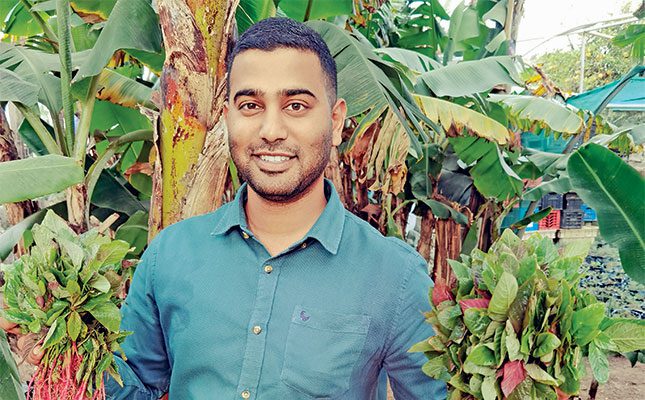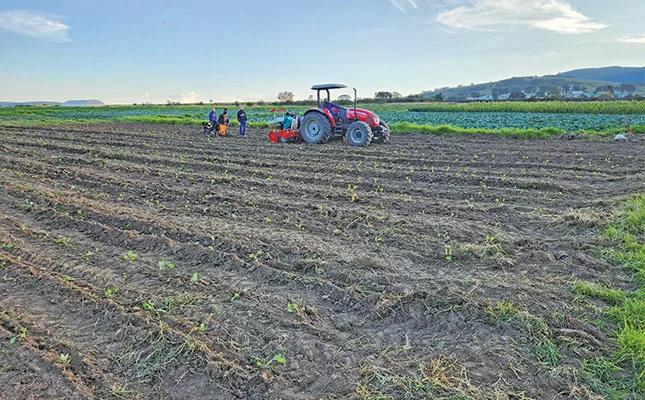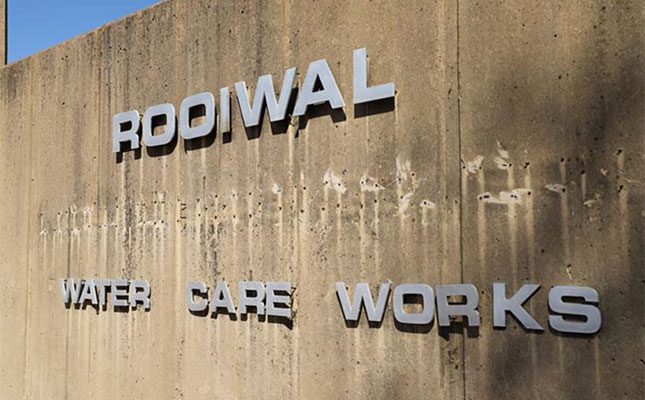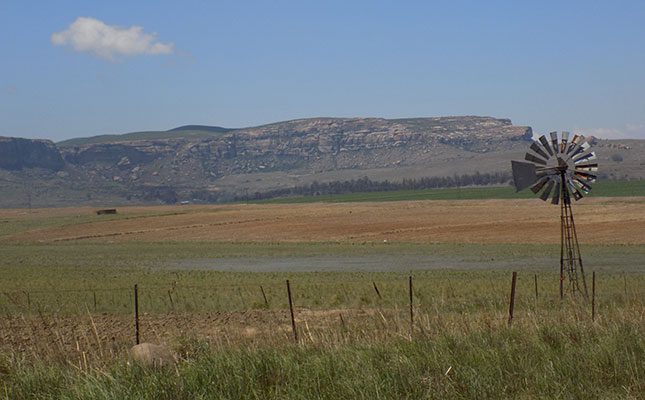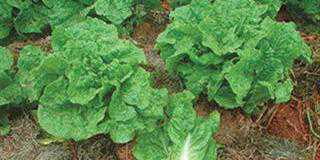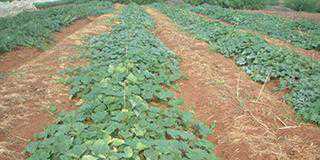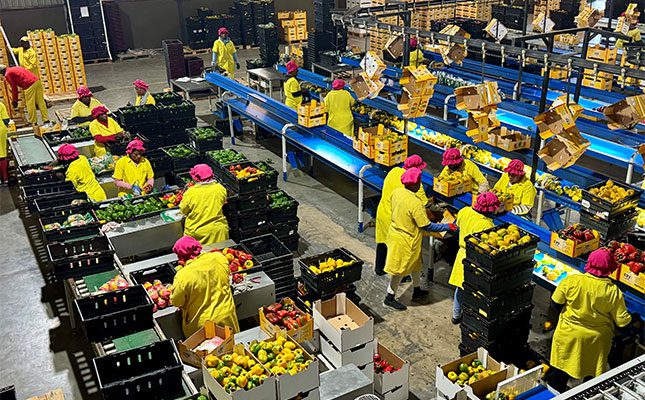
Photo: Magda du Toit
CPJ Erasmus & Seun, run by father and son Kallie Erasmus Snr and Kallie Jnr, has cracked the code to operating a mixed farming operation.
Peppers have always been part of their focus. Erasmus Snr started the business in 1999, planting peppers in an open field. Today, 350ha are dedicated to vegetable production, with bell peppers as the main crop alongside sweetcorn, and butternut, as well as a small crop of green beans.
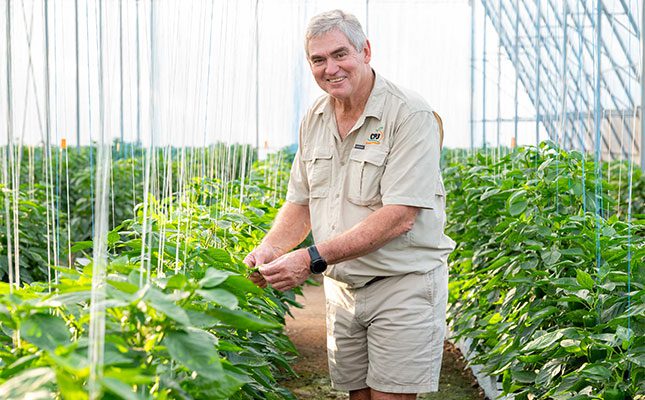
They run a mixed farming operation, with 700ha planted to various citrus cultivars, 30ha under avocados, and 40ha under macadamias. They also run a commercial Bonsmara herd and specialise in game farming.
Most of the citrus and vegetable production takes place in the Letsitele Valley, with additional citrus production near Weipe, and both avocado and macadamia production in George’s Valley and Agatha.
“The cattle are kept on small pieces of land not suitable for citrus or vegetable production or where we do not have enough water to produce crops,” explains Erasmus Jnr.
They have a separate game and cattle farm in Louis Trichardt, where they focus on breeding and hunting.
“Much of the economic value of wildlife can be attributed to horn size, which is an important trait for trophy hunters. We are quite proud of the fact that we were able to breed excellent nyala bulls with horns exceeding 33 inches,” he adds.
With a workforce of 200 permanent staff and an additional 1 100 seasonal staff, it is clear that CPJ Erasmus & Seun plays an important role in creating jobs in the region, adding to its economic viability.
Secret to success
The first thing Erasmus Jnr’s father told him when he started farming was that adaptability was important.
“If you cannot adapt to changes or challenges, you will not be able to achieve success in a farming business. We are constantly bombarded with changing circumstances. One must be able to adjust to survive,” explains Erasmus Jnr.
He adds that the time for waiting on others to act on your behalf has passed. “If you want to bring about changes, the ball is in your court. You have to act or make a plan. Nothing will fall into your lap.”
Record-keeping is another major contributor to their success, he says: “We have hand-written records from my grandfather regarding the weather, yield, input costs, and general events that impacted agriculture, dating back more than 60 years. I also have my grandfather’s Bible with notes regarding droughts and floods.
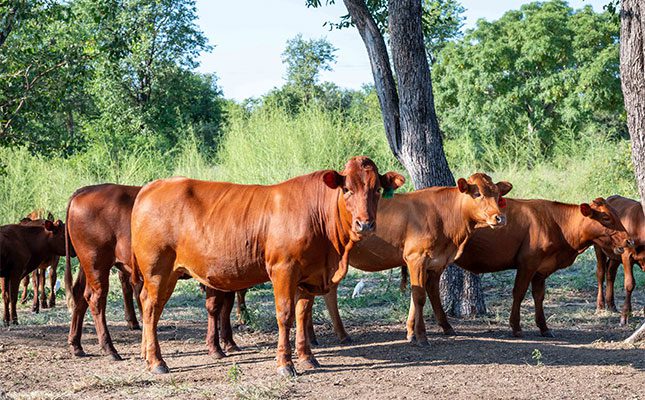
“Apart from the fact that one can see trends, we can take comfort in the fact that those who farmed before us also had to overcome challenges.”
In his personal records, Erasmus Jnr explains, he compares the current year’s costs, activities, and planning with those of the previous year. “I can look at disease prevalence or insect infestations and see what happened last year and what we did to address those situations and when.”
He mentions that cell phones also make things easier, as they can record actions in real time. “Getting photos from field personnel helps us make timely decisions that can save time and money. Quick reactions can protect your reputation.”
Another key principle behind their success is the sharing of information and finding ways for farmers in the area to make collective, non-competitive decisions that benefit everyone.
Planting trials and close collaboration with input suppliers also add value to their business. “Although planting trials create additional work, they give me an idea of how a product will perform in our farming system in advance. Even though the trials are on a smaller scale, I can still use the information [to inform] future purchases and production.
“The more information we have, the more facts we have to base our decisions on,” he says.
Pepper production
Pepper production largely depends on optimal temperatures with minimal variation between minimum and maximum temperatures. The plants generally stop growing at temperatures below 10° to 12°C, with leaves aborting at temperatures below 6°C. The same occurs above 35°C. Such temperature fluctuations can lead to reduced yields and poor fruit quality.
Erasmus Jnr says they plant various pepper varieties at different times and under varied cultivation practices to spread risk and ensure a constant supply throughout the season.
He adds that they have moved away from open-field production and are now focused on intensive production under nets and in greenhouses.
“Shade netting is a simple and effective way to protect peppers against various biotic and abiotic stress factors. In a warm area, such as where we farm, nets help to reduce damage to fruit caused by hail, high temperatures, and solar radiation, and also improve water-use efficiency,” he explains.
“Our production is much higher under nets, but the packout percentage is even more important. With better-quality fruit and greater control over some production conditions, we achieve overall packout percentages of between 90% and 95%, which significantly improves profitability by reducing fruit losses.”
He adds that, as part of their soil management programme, they rotate production under the nets, allowing the soil to rest.
Erasmus Jnr points out the following benefits of producing peppers under nets:
- Sun protection: “While sunlight is vital for growth, UV rays can harm sensitive crops like peppers.”
- Reduced bird damage: birds often feast on peppers as soon as they start colouring in open fields.
- Temperature control: production under cover creates a microclimate conducive to pepper growth.
- Water management: “Netting allows us to reduce irrigation, improving long-term cost-effectiveness.”
- Wind protection: shade nets shield plants from strong winds.
- Pest control: nets can act as a physical barrier against pests such as moths.
- Extended growing seasons: “Controlled conditions protect plants from extreme heat or cold, extending the season.”
- Improved quality: “Under nets, fruit ripens more uniformly, boosting post-harvest quality and packout.”
Under the nets, they plant directly in soil ridges, which provide extra space for root development, and use drip irrigation.
“Drip irrigation is a highly efficient method that delivers water directly to the base of the plants. It minimises evaporation, ensures the water reaches the root zone where it is needed the most, and allows for uniform irrigation of an entire row,” he explains.
In the greenhouse tunnels, the plants are cultivated in bags filled with a bark-based growth medium. Using a low-flow drip irrigation system, peppers are produced in much the same way as in a conventional hydroponic system. “The lower delivery rates of this system enable us to better balance the horizontal and vertical distribution of water,” says Erasmus Jnr.
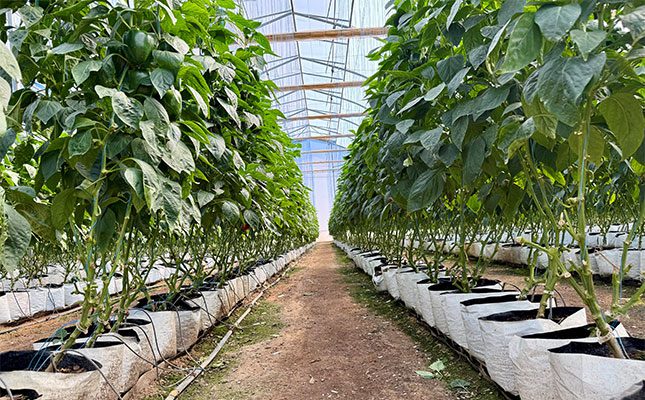
He says the benefits of low-flow drip irrigation are reduced water, fertiliser, and energy use, adding that it offers the ability to increase the application of nutrients during specific phenological stages of the plant, giving them more control over fruit size and colour.
“Careful selection of pepper varieties, stringent nutrient management, and lighting are crucial for successful production under these conditions,” Erasmus Jnr points out. He adds that although the cost is higher, the gains in yield and quality justify the expense.
Peppers are planted at a density of 30 000 plants per hectare. Most plants are trained to two stems on supporting strings, stopping at a height of 3,5m high under netting and up to 4,5m in the greenhouses.
The input cost for production under netting is approximately R650 000/ha, while in the greenhouses it rises to R1 million/ha, including plant bags and growth medium. This excludes the initial cost of the netting and greenhouse structures.
It takes about 10 to 12 weeks from planting for the peppers to be mature enough to be picked.
“We remove the first flowers, as the plant is not yet strong enough to carry fruit and the roots aren’t properly developed. Fewer peppers per plant also results in more uniform, medium-sized fruit, rather than a mix of small and large peppers,” explains Erasmus Jnr.
The internodes on a pepper plant should be medium-long – not too long or too short. If too long, the plant grows tall, yields fewer peppers, and is harder to harvest. If too short, the plant may produce more fruit than it can support, and closely packed peppers can damage each other.
The ideal is a plant with bigger peppers at the bottom and smaller ones at the top. The peppers are picked by hand, starting at the bottom of the plant, and over a period of a couple of weeks, the pickers will work upwards as the fruit matures.
Their average yield is 70t/ha to 90 t/ha. With the high packout percentage, they are able to produce 4 700t of peppers, which means they deliver just under one million 5kg boxes of peppers to the market from May to December. Fruit that doesn’t meet retail standards is sold in local markets across South Africa.
Erasmus Jnr notes that soil health and biology are critical: “We regularly test our soil, and compost and microbes are added as needed.”
One option they use is biostimulants, which are naturally occurring biological products that enhance plant productivity by modulating metabolism. Unlike conventional fertilisers, biostimulants, when used in conjunction with traditional crop management strategies, offer the added benefit of protection against abiotic stress.
Fertigation is done through the irrigation system.
After harvesting, the plants must be removed. “We make sure to remove all the roots so they don’t provide a habitat for soil-borne diseases. The removed plants are then stacked and burnt to prevent the spread of disease,” explains Erasmus Jnr.
Before planting, the soil under the nets is fumigated to kill fungi and nematodes.

Other vegetables
- Sweetcorn
Sweetcorn is planted from March and harvested between June and October. “The cold chain is crucial for sweetcorn, and large temperature fluctuations can affect product quality. Load-shedding during processing and packaging causes problems, not just with quality but also in terms of downtime,” says Erasmus.
- Butternut
For the past 15 years, they have produced the same butternut varieties. “We struggle to obtain a new variety that is adapted to our area. The season often starts well, promising a good yield, but by week 10, we pick up fungal infections like downy mildew, which can reduce our harvestable yield to such an extent that we are considering stopping butternut production altogether.
“Butternut also suffers from viral infections due to aphids and whitefly early in the season,” he explains.
On some fields previously used for open-field pepper production, they plant cover and fodder crops for livestock feed.
- Citrus
Pomelo, various orange varieties, and soft citrus are grown in Letsitele, and lemons and Valencias in Weipe. The citrus is mainly aimed at the export market, while the vegetables are predominantly produced for the domestic market.

- Avocados
Varous varieties are planted, all for the export market.
Marketing
Erasmus Jnr’s brother-in-law, Gerrit Theron, is the marketing manager at CPJ Erasmus & Seun and is responsible for managing their direct marketing channel.
According to Theron, about 70% of their products are marketed directly. Peppers are mostly sold on the local market and through retail, with some exported to islands such as the Maldives and Mauritius. Avocados are shipped to Europe, Russia, and the Far East.
Star ruby grapefruit is exported to the Middle East; Valencia oranges to the Middle East and India; lemons to various countries in Europe, Russia, the Middle East, Canada, and the Far East; and soft citrus to Russia, the EU, the Middle East, and Malaysia.

Challenges
While new technologies provide solutions for sustainable food production, certain factors still pose seasonal challenges, with some proving more difficult to manage than others. Erasmus Jnr says these hurdles force them to think differently to find solutions.
According to him, some of the challenges are:
- Water
For all farmers in the area, water supply remains a challenge. Their main source of irrigation water, the Tzaneen Dam, is currently at 67% capacity.
“Although we received relatively good rainfall over the past two seasons, water availability remains a long-term concern. The good news is that work has already started to increase the dam’s capacity,” he says.
He adds that it’s not just water availability that poses challenges but water quality, too. “Peppers are extremely sensitive to changes in water quality. We installed a state-of-the-art osmosis system that allows us to manage water quality and fertigate the peppers through the irrigation system.
“We test water quality continuously, and the information is delivered in real time to my phone. The moment we pick up a problem, we can act immediately and make adjustments.”
- Input costs
Input costs are also a concern, particularly the rising price of fertilisers, especially nitrogen.
- Infrastructure
“As with all export farmers, congestion at the ports remains a concern,” says Erasmus Jnr.
He adds that the state of the roads also affects product quality: “Farmers in the [Limpopo] area have come together, and we try to maintain the Eiland Road ourselves, at our own cost.”
However, he stresses that one of the main challenges is the state of local fresh produce markets. “The industry still uses the local markets to set prices, but we don’t deliver our premium products to these markets because of the state they’re in.
“The products that fall outside the parameters of the retail industry go to the markets, yet these products are used to determine our prices.”
With regard to electricity, Erasmus Jnr says persistent load-shedding negatively affects production, especially for farmers who rely on irrigation.
“It is not only the lack of electricity that presents the problem; without it, we can’t pump water from the the Greater Letaba water scheme, meaning we can’t irrigate or fertigate our crops, and the packhouse comes to a complete standstill.
“Although we have invested in generators, they require a huge financial [outlay], as well as ongoing diesel costs,” he explains.
He says they are exploring solar power, particularly for the greenhouses, which would at least allow daytime irrigation, especially on hot days when plants lose large amounts of water through transpiration.
- Insects and diseases
Pest control on the farm includes spraying for aphids, thrips, whitefly, and other sucking insects. “Thrips are a particular problem because the farm is in a citrus area. They are difficult to control because they crawl inside the flower of the plant,” explains Erasmus Jnr.
He adds that they are also aware of a new insect recently detected in the area. Gall fly, or gall wasp, is a small insect that lays its eggs in flowers, causing abnormal growth and misshapen fruit.
Currently, there are no registered products to control this pest, and very little research is being done on it. “Once they are in the area, it seems almost impossible to get rid of them,” he says.
They use an integrated pest management system on citrus, incorporating biological control methods.
- Availability of new products
The availability of new and replacement crop protection products is a concern for farmers, says Erasmus Jnr.
“With several crop protection products removed from the market, we are severely limited in what we can use. We do our best to prevent insect resistance by using products from different classifications and modes of action.
“However, in an area like ours, where farms are close together, the limited range of active ingredients can still lead to the overuse of certain compounds and the development of resistance. We try to coordinate with our neighbours, but it isn’t always possible or successful.”
He emphasises that it’s crucial for input suppliers to address this problem collectively.
Erasmus Jnr adds that this applies not only to chemical products but also to vegetable varieties: “Some of the varieties we plant have been on the market for more than 15 years, and we still don’t have new products adapted to our production area.”
He adds that he works closely with most input suppliers to see how they can manage these challenges: “Cooperation and constant communication regarding trial results are imperative.”
- Theft
Since CPJ Erasmus & Seun Boerdery produces edible crops, theft remains an issue, particularly with citrus. “We erect fences and security systems, but theft is still a problem in our area,” says Erasmus Jnr.
Focused on the future, this father-and-son team isn’t afraid to take calculated risks, always prioritising quality and taking pride in their work.
For more information email CPJ Erasmus & Seun Boerdery at [email protected].


